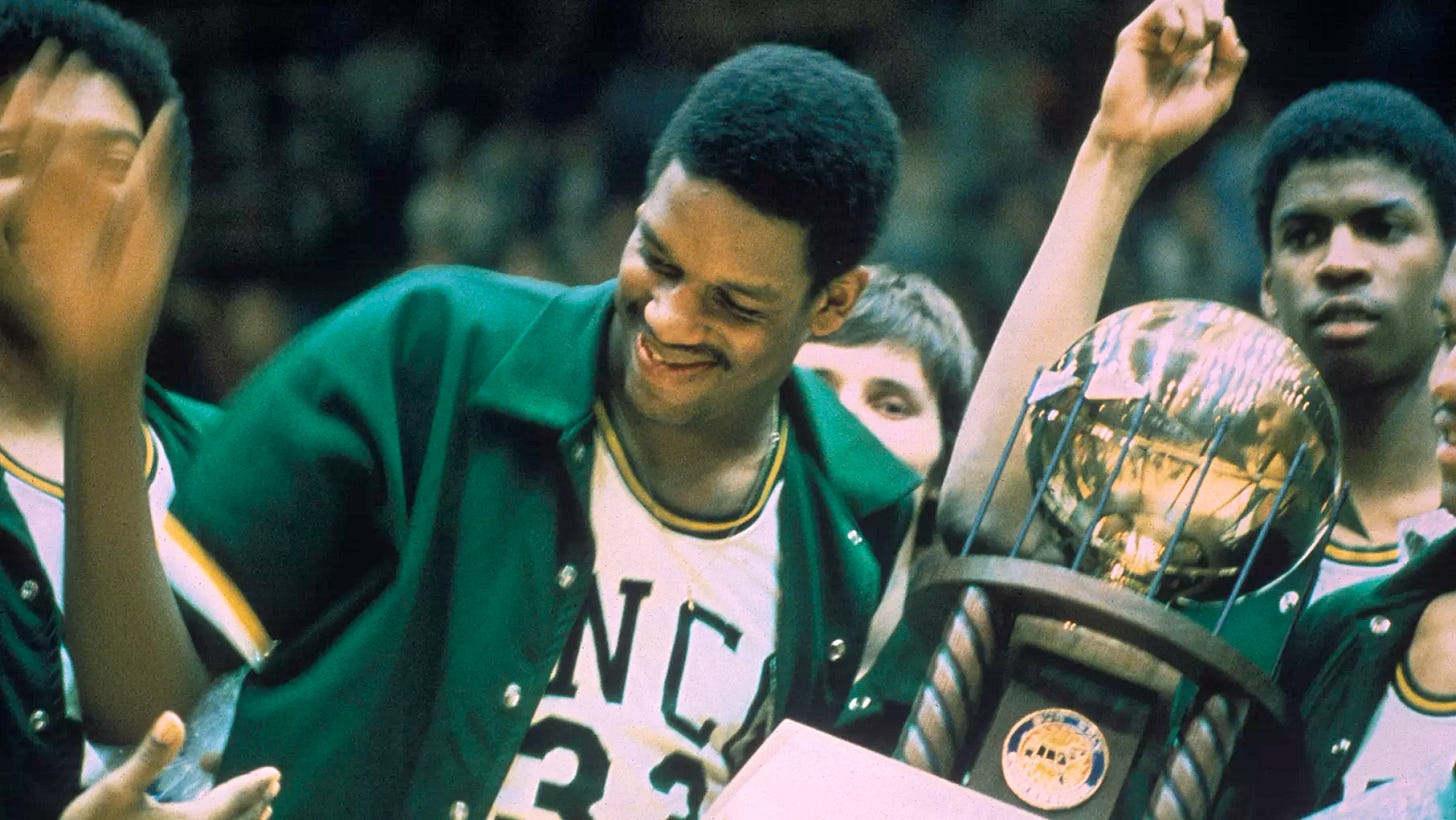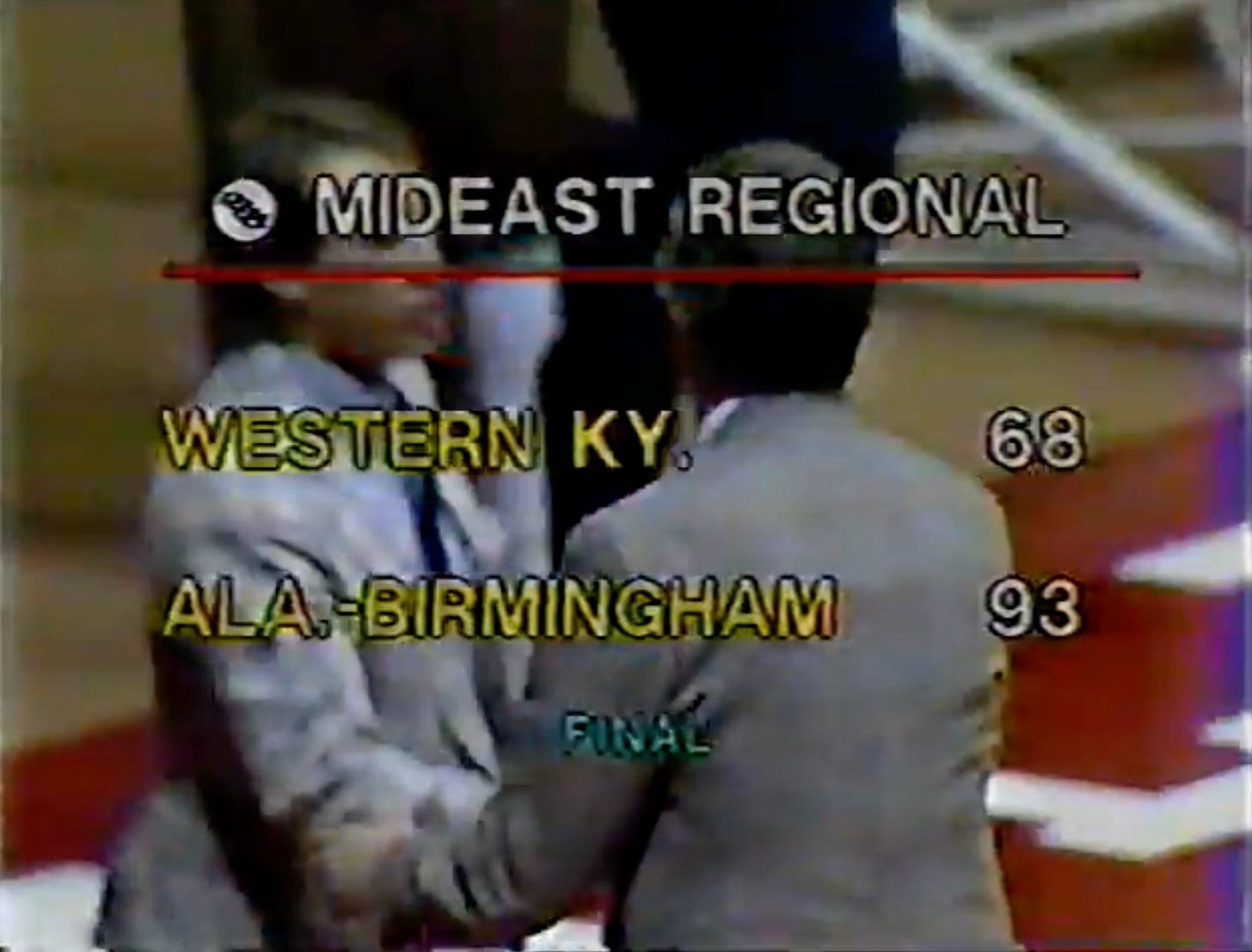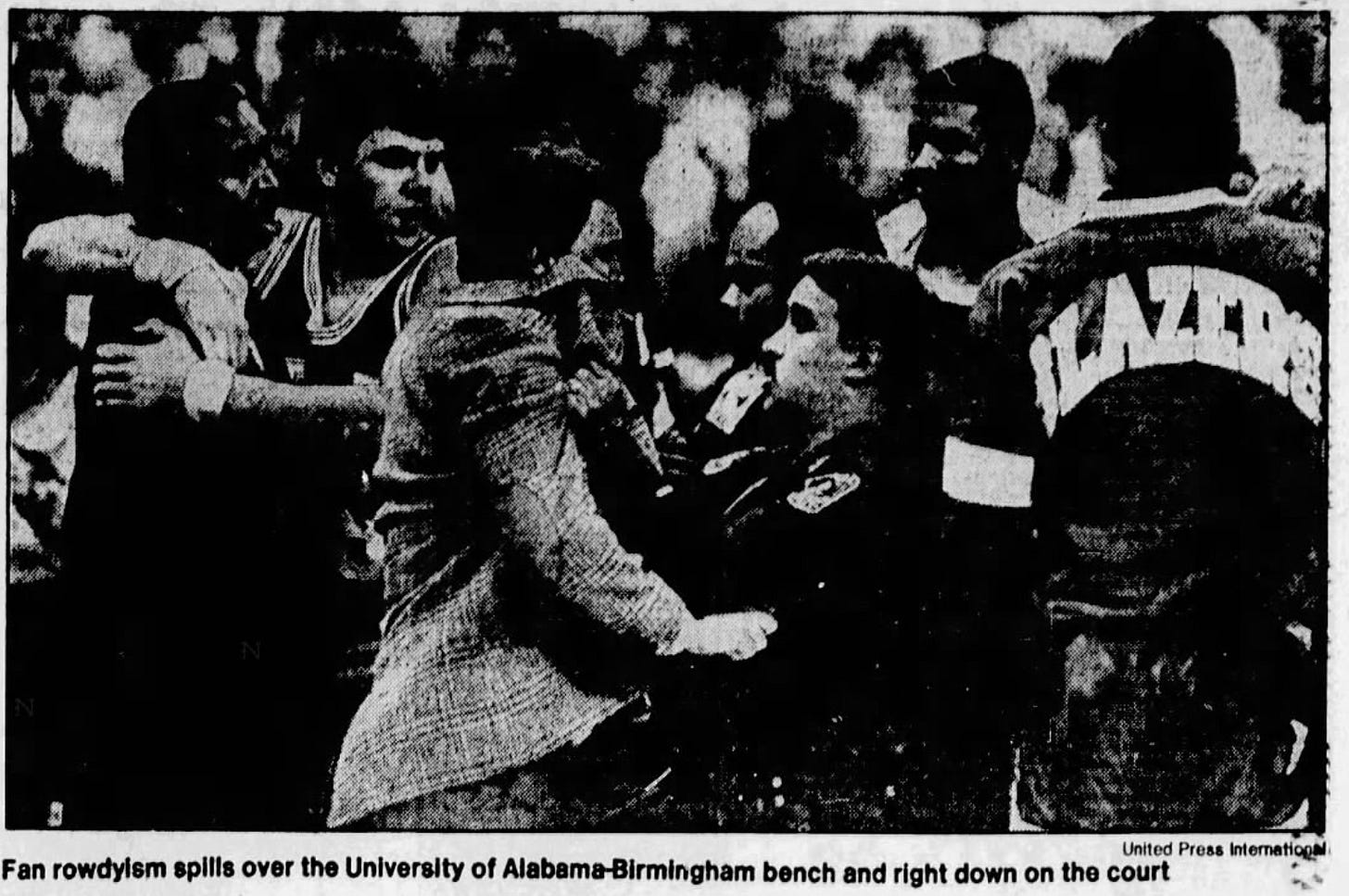The Mars Bars Game
The story behind one of the most bizarre nights in UAB basketball history.
November 1985
The Western Kentucky Hilltoppers were one of the most successful mid-major programs of the 1960s and 1970s, posting 16 winning seasons, appearing in eight NCAA Tournaments, and reaching one Final Four over the course of two decades. Their dominance was particularly pronounced at the conference level: a founding member of the Ohio Valley Conference, WKU shared or outright won 19 league titles during its 33 years of membership.
OVC basketball was an intensely local affair in the 70s, a time when the league was made up of WKU, Morehead State, Eastern Kentucky, Murray State, Middle Tennessee State, Tennessee Tech, East Tennessee State, and Austin Peay. As was the case with many of the era’s conferences, it was a true bus league, meaning all of its members were within a couple hours’ drive of one another. “Ohio Valley” was a rule, not a suggestion.
Although its geographic density kept travel costs down, the OVC’s roster of small, regional, public schools also limited the conference’s all-important earning potential. As the industry of college sports grew more and more lucrative, regionalism came to be viewed less as a laudable quality and more as a hindrance. In the 1986 words of former WKU president John Minton: “The OVC over the years was faced with the problem of exposure. There was a bit of a feeling that if you could get out of the OVC, you could break out of the mold of regionalism.”
Even before the advent of today’s sports media ecosystem, a league with the OVC’s profile was never going to compete in major advertising and television markets, a fact WKU’s administration had recognized by the early 80s. The Hilltoppers wanted to cash in the success of their basketball program in exchange for exposure; a young, burgeoning Sun Belt Conference offered them the opportunity to do just that. Founded in 1976, the SBC never concerned itself with being a bus league, name aside.
“Geographically, the six teams seem worlds apart,” read a 1976 Raleigh News & Observer article, referring to Charlotte, Georgia State, Jacksonville, New Orleans, South Alabama, and South Florida, the conference’s inaugural members. Instead of chasing OVC-style geographic density, the SBC initially sought out Southern metropolitan universities, a philosophy further evidenced by the league’s 1979 additions of UAB and VCU.
By the turn of the decade, the SBC had produced several excellent basketball teams, with none being greater than Charlotte’s 1977 Final Four squad. These successes, in combination with the conference’s presence in populous metro areas, earned the league an impressive distribution package. During the 1981-1982 basketball season, two SBC games were broadcast on national television, three were broadcast on regional television, 13 were broadcast on ESPN — the Sun Belt was the first conference to sign a long-term deal with ESPN — and seven were broadcast on the league’s own television network.
This was enough to sell WKU. On March 8th, 1982, the university’s board of regents unanimously voted to withdraw from the OVC and accept an invitation to join the Sun Belt Conference.
“The potential [in the Sun Belt] for those areas in revenue income is much greater than we can expect in the Ohio Valley Conference,” said WKU president Donald Zacharias, who later estimated that one national television appearance would cover the Hilltoppers’ travel expenses for up to three years. “Our opportunity for national and regional television exposure [in the Sun Belt] is much greater than it would be [in the OVC].”
Western Kentucky began Sun Belt play immediately; they were picked a semi-generous fifth out of eight in the 1982-1983 conference preseason media poll. WKU head coach Clem Haskins was optimistic about his team’s fortunes, although he did acknowledge the step up in competition would be drastic, calling the ‘82-’83 schedule “the most difficult in Western history.” Jim Greisch, sports editor of the Madisonville, Kentucky paper, concurred, writing: “For years, Western had the only real big man in the OVC… Now, Western is entering a league filled with 6-9 and 6-10 players.”
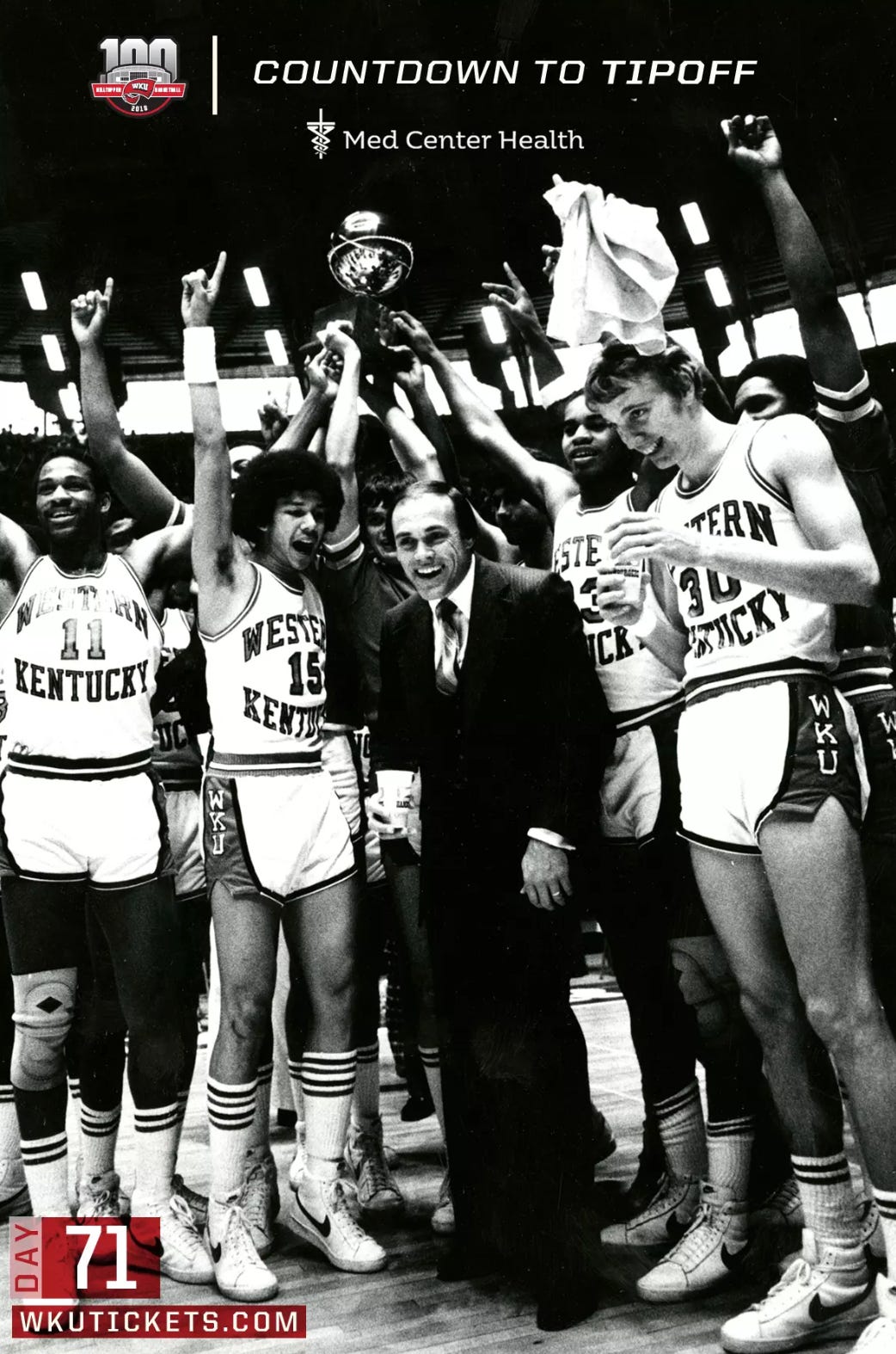
Although both Haskins and Greisch held measured expectations, neither man adequately predicted the extent to which the Hilltoppers would struggle to adapt to their new league. WKU, which hadn’t finished below .500 in conference play since 1973, posted a 4-10 conference record in ‘82-’83, a 5-9 conference record in ‘83-’84, and a 5-9 conference record in ‘84-’85. The Toppers were never apocalyptically bad during this stretch, but Western Kentucky fans were spoiled from years of OVC dominance; in the early months of 1985, rumors began to circulate that Haskins wasn’t long for Bowling Green. Although the WKU board publicly reaffirmed its commitment to the coach, it was clear his seat was getting warmer and warmer.
“We jumped into a situation where we had no idea the Sun Belt Conference was this tough from top to bottom,” Haskins would later say. “I underestimated the conference as a coach, and so did our fans.”
Thus, Haskins entered the 1985-1986 season tasked with proving that the Hilltoppers could compete in the Sun Belt, and furthermore, that he was the right man to lead them. For both team and coach, the path to respectability ran through Birmingham.
January 1986
For the first four years of their rivalry, coach Gene Bartow’s Blazers absolutely dominated Haskins’ squad.
The programs first met in the 1981 NCAA Tournament, when an Oliver Robinson-led UAB team drilled WKU by a final score of 93-68.
Things would only get worse after Western joined the Sun Belt, as the Blazers beat the Hilltoppers six times from January 1983 to March 1985, winning each game by an average margin of eight points. At the beginning of the 1985-1986 season, UAB’s all-time record against WKU was an astonishing 7-1.
But by the first month of 1986, it was clear that this was not the same old Western Kentucky. Thanks to an impressive non-conference resume that included wins over Middle Tennessee, Cincinnati, and #19 Auburn, morale around the program was the highest it has been in nearly half a decade — the Hilltoppers boasted a sparkling record of 9-3 at January’s halfway point. On the verge of unemployment less than a year prior, Haskins was now being mentioned as a candidate for high-major jobs.
WKU’s dream season continued when the Hilltoppers pulled off an overtime upset of UAB in Birmingham on January 16th. This was no slouch of a Blazer squad; led by All-American guard Steve Mitchell, the Green and Gold were ranked 12th in the nation and had previously lost only two games all season. It was Western’s highest-ranked Sun Belt win of all time and their first-ever win at the BJCC. Haskins was highly aware of the significance of the victory, as was the Birmingham Post-Herald, which titled its recap article “Hilltoppers finally climb UAB mountain.”
“This means a whole lot to us,” Haskins said. “We’re trying to compete with all the big ones, and the only way to get recognition is to beat people like UAB. This should prove to our critics that we can compete in the tough Sun Belt Conference.”
However, not all observers were convinced. There was a prevailing sentiment that the Blazers had given the game away more than the Hilltoppers had won it. UAB held a nine-point lead with 12 minutes remaining but saw its advantage evaporate after a series of unfortunate events, some of which were out of the Blazers’ control. Bartow’s team committed 22 turnovers on the night, had two late points wiped off the board by a questionable basket interference call on forward Anthony Gordon, had a potential Steve Mitchell game-winner bounce off the rim, and were finally sunk by a highly contested buzzer-beater from WKU’s Billy Gordon.
“We didn’t get much credit for winning that game,” said Haskins. “Everybody said, ‘Golly, that was a fluke.’”
Although Bartow gave the Hilltoppers props for playing well, he didn’t sound like a man that believed his team had been beaten outright.
“Turnovers when we took the lead killed us,” he said. “This was a typical last-three-years exhibition of hot-doggishness and sickening turnovers when we have a chance to put someone away… This is one of the most sickening losses I’ve ever been associated with.”
“I think we had [Billy Gordon] defensed,” Bartow added. “He just hit a great shot.”
Blazer guard Michael Charles, on the other hand, was more explicit: WKU got lucky.
“What does bother me is that Western shouldn’t have beaten us last time,” Charles said in an interview conducted prior to the teams’ next meeting. “Don’t get me wrong, I think they’ve got a good team. But I think we’re better.”
It was clear that UAB believed the Hilltoppers’ win to be a blip on the radar, while WKU was adamant it represented their emergence onto the big stage. There was only one way to settle this: round two, this time in E.A. Diddle Arena. Described by multiple outlets as the Sun Belt’s presumptive game of the year, the January 25th rematch was played with the rivals now tied atop the conference standings.
The Mars Bars Game
The scene in Bowling Green was like nothing Western Kentucky had seen in years.
“We’ve put people in places we didn’t even know we had,” said WKU SID Paul Just.
The audience that gathered to watch the Blazers square off against the Hilltoppers exceeded Diddle Arena’s capacity; at over 13,300, it represented the stadium’s largest crowd since 1980. Scattered throughout the arena was a sizable contingent of visiting UAB supporters, many of which had been ferried up 1-65 by student buses. Distributed among this great mass of people were thousands of complimentary Mars Bars.
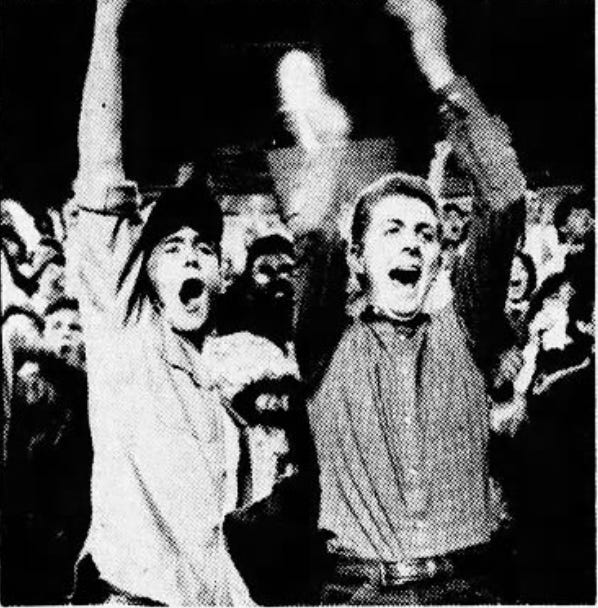
At one end of the arena hung a banner triumphantly proclaiming the Hilltoppers’ intent to reshape the Sun Belt power hierarchy: “UAB is a thing of the past, WKU is here at last.”
Doing battle in front of this enraptured crowd were two teams known for their physicality and toughness. As Post-Herald reporter Roger Shuler wrote:
The areas around the baskets may look like a scene from “Rambo” tonight when the UAB Blazers and Western Kentucky University square off.
It will be a matchup of the Sun Belt Conference’s two most physical teams. Both have plenty of height, bulk, and sheer nastiness among their front-line players.
UAB had at its disposal a stable of frontcourt players, the most productive of whom were Jerome Mincy, Archie Johnson, and Anthony “Big Jack” Gordon. Mincy was the star of the group, the name at the top of any scouting report. The Memphis native averaged 14.1 points and 8.4 rebounds per game during the 1985-1986 season, a performance that would earn him All-Sun Belt honors and a fifth-round selection in the 1986 NBA Draft. When asked which UAB players he was most worried about, Haskins fingered Mincy and guard Steve Mitchell as the Blazers’ two biggest threats.
WKU’s frontline was manned by towering forwards Kannard Johnson, Tellis Frank, and Clarence Martin, the first two of whom would go on to play in the NBA and the latter of whom was an Alexander City native who spurned the Blazers to play for Haskins at Western. Martin was a well-known enforcer on the court; UAB was familiar with his antics, as he broke Mincy’s nose in a January 1984 game and flagrantly fouled Mitchell in a February 1985 game. Martin ripped down ten rebounds in the rivals’ January 16th meeting and would play an even more central role in the second contest.
To further exacerbate any potential nastiness, both the Blazers and the Hilltoppers entered the night running high on emotion. UAB was mired in frustration, having dropped a game to DePaul after their original loss to Western. Their poll rating had plummeted from 12th to 18th, guard James Ponder was suffering through an extended shooting slump, and the team’s chemistry was in question. Western, on the other hand, was now 12-3 on the season with the memory of Bartow’s “sickening” comments fresh in their minds.
“The pressure is on them,” said Haskins. “I hope what Coach Bartow said will inspire [our players]. I’m fired up. We know the importance of this game.”
Tipoff
UAB started Steve Mitchell, James Ponder, Michael Charles, Jerome Mincy, and Archie Johnson, while WKU started Billy Gordon, the hero of the first game, James McNary, the SBC assists leader who missed the first game with an injury, Kannard Johnson, Clarence Martin, and Fred Tisdale.
It was McNary who opened the scoring with a baseline fadeaway, but UAB’s backcourt duo briefly silenced the partisan crowd. Ponder nailed a jumper from the top of the key. The incomparable Mitchell drained two deep buckets to give the Blazers their first lead of the game.
Ponder and Mitchell continued to dazzle for much of the first half, combining to score UAB’s first 12 points, but the Hilltoppers seemed to have a response to every Blazer basket. A nasty cut opened up on Jerome Mincy’s forehead as Haskins’ squad began to assert dominance over the boards; the Hilltoppers pounded the offensive glass, sending in wave after wave of bench players to gash the Blazers on the interior. Standing just 6’3” tall, the little-used Ray Swogger slipped through the trees and scored four points off putbacks, reigniting the Diddle Arena faithful. Bartow directed a tirade at the officials during the first media timeout, but it did little to quell the home team’s onslaught. The UAB coach would later call WKU’s first-half offensive rebounding “the best I’ve ever seen.”
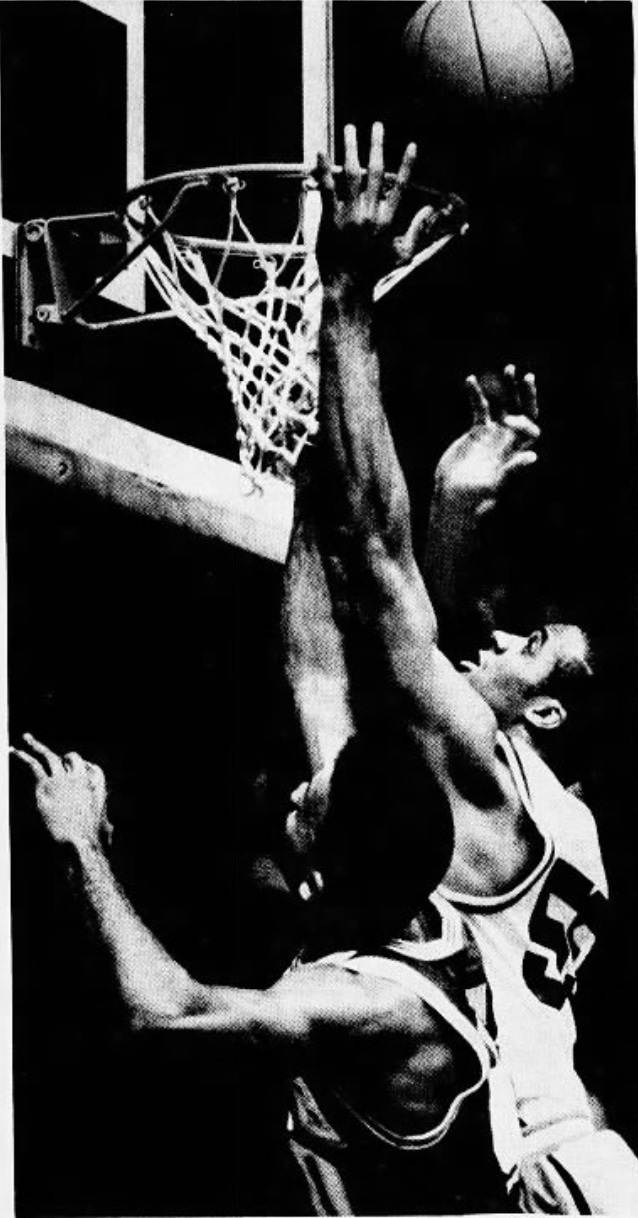
Mitchell, who single-handedly kept the Blazers within striking distance for much of the first period, entered the locker room with 17 points, but the efforts of Gordon, Martin, and the reserves Frank and Swogger staked the Hilltoppers to a 44-36 halftime lead.
“They’re a big team and our big people had been struggling a little,” Bartow said. “We probably became too guard-oriented tonight.”
“It was a very aggressive, physical game,” Mincy said. “We knew they had one of the strongest frontlines in the league, and they had more bench power than we did. That was the difference.”
The opening minutes of the second half went similarly poorly for the Blazers — their deficit remained unchanged, and WKU continued to dominate the interior.
It seemed UAB had at last caught a break when the Hilltoppers’ Martin, who scored ten points in the first half, picked up two rapid-fire whistles, bringing him to four fouls on the night. Haskins elected to keep the forward on the court, a decision which quickly backfired after Martin attempted to jump over Mincy for his second putback dunk of the game. The officials deemed the play an offensive foul, and with 12:38 remaining, the Hilltoppers had lost their enforcer.
The admittedly-borderline call did not sit well with the rambunctious Diddle crowd: several members of the WKU faithful began to shower the court with cups, ice, and Mars Bars, which somehow remained uneaten over an hour after most fans entered the doors. Many of these projectiles were launched with intent and malice, directed at the man who described losing to Western Kentucky as “sickening.” Per a recollection published in the Post-Herald, one candy bar hit Bartow in the leg, while another whizzed by his head.
UAB forward Bruce Baker, an enforcer in his own right, grabbed one of the bars and hurled it back into the crowd. Brent Woods of The College Heights Herald claimed that Baker nailed a spectator in the face.
Woods attempted to exonerate the WKU student section of wrongdoing, writing that the students were corralled in the cheap nosebleed seats and that the bars likely came from the lower levels; whoever the culprit, the Blazer bench was furious. Bartow attempted to pull his team off the court before Haskins grabbed the PA mic and begged Western’s supporters to stop throwing candy.
With the encouragement of their coach, the crowd eventually calmed down. It wasn’t long before the floor was clear and play was ready to resume, now with additional security behind the UAB bench. Surprisingly, the Blazers immediately looked more composed than they had all night — Mincy sparked a furious comeback that saw WKU’s nine-point lead disappear in the blink of an eye. A 10-1 UAB run tied the game at 65 with fewer than four minutes left on the game clock.
The Blazers and Hilltoppers traded buckets for the next several minutes, but just as he had in the first game, WKU’s Gordon hit a crucial baseline jumper to give his team a late lead. The score was now 73-71 with 1:15 left. Ponder’s subsequent jumper couldn’t find paydirt, and in the era of the 45-second shot clock, the Blazers were forced into a cycle of fouling. Six free throws gave the home team its first — and to this day only — conference sweep of UAB. Western Kentucky had arrived.
On the UAB side of things, much of the postgame discussion was shaped by the candy-throwing incident. Western Kentucky’s fans were known to be rowdy — in 1984, Bowling Green businessman Ken Johnson taunted a Carson-Newman player into the Diddle Arena stands, where the player was struck over the head with a folding chair — and it wasn’t the first time Bartow had taken issue with their sportsmanship. He again ripped the Hilltopper faithful during his postgame radio show.
“In my 24 years of coaching, that’s the first time I’ve ever been hit with anything,” he said. “It really bothers me.”
The UAB coach then refused to make an appearance at the subsequent press conference, although he validated WKU at long last: “We just got beat.”
On the other hand, Western’s postgame discussion mostly glossed over the incident. In the days following the game, there was some editorializing in the local papers about how WKU fans needed to be better, but in the moment, an ecstatic Hilltopper team did nothing but celebrate.
“I don’t have the words to explain how I feel right now,” Haskins said. “…There’s no doubt that UAB is now our biggest rival in the Sun Belt Conference.”
“I’m thrilled with the performance, and the crowd was the sixth man tonight,” he added. “…There was no way [we] were going to lose in front of this sellout crowd.”
Haskins would later attempt to handwave away the whole affair, saying, “The [incident] was blown way out of proportion by the news media. There was some ice and one candy bar thrown. And the person was taken down and booked. We’d just like to drop the whole thing.”
Aftermath
Although the Mars Bars game remains one of the odder incidents in Blazer basketball history, it didn’t receive much national coverage. However, it did serve as the basis for significant rule changes after UAB was faced with a similar situation the following week. In the wake of the loss at Diddle, the Blazers dusted themselves off, beat South Florida, then headed to Old Dominion, where a crowd just as raucous as Western Kentucky’s awaited them.
That crowd proceeded to dump ice and trash onto the Blazer bench after another unfavorable offensive foul call. A swarm of fans attempted to grab UAB’s players, with one taking a swing at Bartow. ODU supporters pelted the Blazers with drinks as they made their escape into the locker room.
The incident was even more severe than the one at WKU and lacked the quaint charm of the candy bar barrage. Bartow theorized that the Blazers had become a target because of their status as a Sun Belt titan.
“It was a bad night for college basketball,” he said. “I’ve been in coaching 24 years and in the last two games I’ve seen more ugliness than in all the other years combined.”
SBC commissioner Vic Bubas immediately issued an order implementing the following rules at all conference games:
Additional security near team benches.
All home team coaches and athletic administrators must be more visible and quicker to use public address systems to warn crowds that technical fouls might be called.
Cheerleaders and mascots must be warned about taunting opposing players.
Promotional items that can be thrown onto the court, such as candy bars or megaphones, must be handed out after games or such promotions will be discontinued.
Bartow welcomed the rule changes, although he was offended by Bubas’ reprimand of “every school and coach involved,” believing the Blazers were the clear victims in both situations. Already-circulating rumors of UAB’s desire to leave the Sun Belt intensified after this incident — that’s a story for another time.
As for Western Kentucky, the Mars Bars game did, in fact, prove they were capable of competing in the Sun Belt. WKU went on to finish second in the conference standings — one spot above UAB — an achievement they parlayed into an NCAA Tournament berth. Both Haskins and his Hilltoppers were given their long-awaited recognition; the early-80s perception of them as a program clinging to memories of OVC glory was no more.
Haskins would be hired by Minnesota over the offseason, but WKU continued rolling under new coach Murray Arnold. The following season, they’d win the Sun Belt regular season title for the first time in program history and make another NCAA Tournament.
But one persistent obstacle remained in the Hilltoppers’ way. At the end of the 1985-1986 campaign, WKU and UAB met in the BJCC once more, this time in the conference tournament. After the Blazers’ opening-round win over South Alabama, many fans in Green and Gold stuck around to root for South Florida, the opening-round opponent of the hated Toppers. The Bulls couldn’t pull off the victory, so UAB had to do it themselves, demolishing WKU in the semifinals by a score of 57-45. In a cathartic display, the Blazers smothered the Hilltopper frontcourt, holding Tellis Frank, Kannard Johnson, and Clarence Martin to 12 points combined.
In the title game of the 1987 conference tournament, UAB made a return trip to Diddle Arena to take on the Sun Belt regular season champions, upsetting the hosts 72-70 behind an impressive outing from guard Tracy Foster.
The defeat would send the Hilltoppers into Sun Belt purgatory. Graduation and transfer losses soon ravaged the WKU roster, and they wouldn’t be relevant in league play again until 1992, the year after the Blazers moved to Great Midwest Conference.
Western Kentucky won the battle. UAB won the war.




